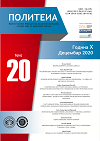Alternativne umetničke prakse između moći države i granica slobode
Alternative Art Practices Between the Power of the State and the Boundaries of Freedom
Author(s): Jelena S. PetkovićSubject(s): Government/Political systems, Politics and society, Culture and social structure , Sociology of Culture, Sociology of Politics, Sociology of Art
Published by: Fakultet političkih nauka Univerziteta u Banjoj Luci
Keywords: Art; alternative; social values; popular culture; Islam;
Summary/Abstract: Starting from Theodore Adorno’s point of view that the sociability of art is shown through its anti-social character, the paper deals with a sociological analysis of alternative artistic practices and their social reach and boundaries. Associated with a very specific social context, with a clearly established deviation not only from the mainstream of the official, elite art (artistic formalism) but also from the dominant culture and prevailing social values, alternative artistic practices are considered in the context of critical cultural counter-public, which is positioned between the formal and the symbolic powers of the state, on the one hand, and the personal / creative and social freedom of the artist and recipients, on the other hand. In the first part of the paper, we are presented with a general review of the transformations as regards the spheres of artistic creation, reception, and evaluation, which started establishing themselves within Western societies as of the beginning of 20th century, as well as with questioning their most important social functions. Following the existing research and using secondary data sources, the paper continues with an analysis of the underground music scene and lifestyles of young people in Western societies, as well as of those that emerged under the influence of the spread of Western popular culture and art in authoritarian regimes of some Muslim countries in the Middle East, North Africa, and Southeast Asia. Although still sporadic, rather marginalized and regime-controlled, these alternative artistic practices contribute to trans-cultural communication and creative and value synergy, gradually undermining rigid social frameworks and belief systems within different societies (Western and Arab-Islamic) but also between them.
Journal: Politeia - Naučni časopis Fakulteta političkih nauka u Banjoj Luci za društvena pitanja
- Issue Year: 11/2021
- Issue No: 22
- Page Range: 55-67
- Page Count: 13
- Language: Serbian

